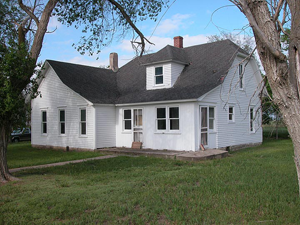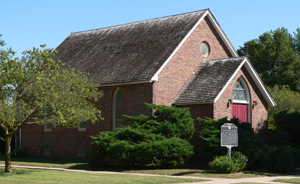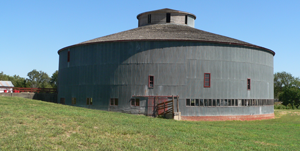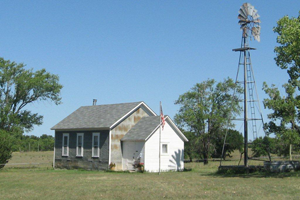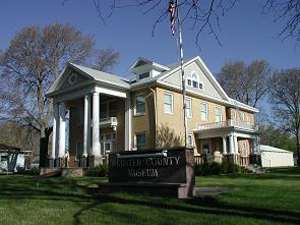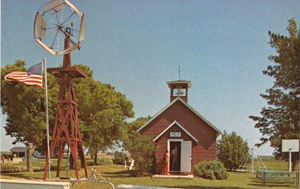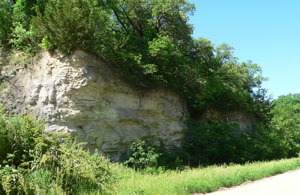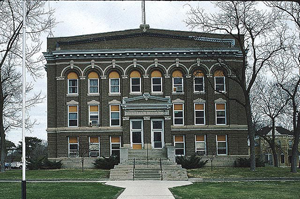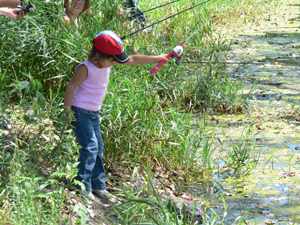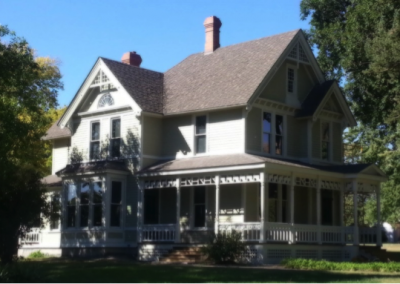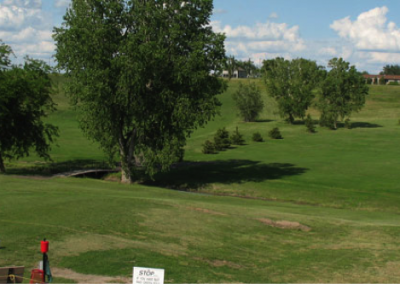Webster County
History
Webster County, located in the southern tier of counties approximately 150 miles west of the Missouri River, was first settled by whites in the spring of 1870. The first group consisted of 19 members of the Rankin colony of Omaha and a second group arrived from Beatrice later that same year. On April 19, 1871, an election was held to organize the county and to locate the county seat, although the boundaries had earlier been defined by a state legislative act approved February 16, 1867. The organization of the county was approved by the voters and the county seat was located at Red Cloud. This community, the first in the county, was settled by Silas Garber, and was conveniently located in relation to the more densely populated portion of the county.
Webster County was named in honor of Daniel Webster (1782-1852), the American statesman.
Red Cloud History
www.RedCloudGuideRock.com
Willard Thorp, in American Writing in the Twentieth Century says, “from the literary standpoint, Red Cloud ranks as one of the most famous villages in American Literature.” This is because Red Cloud is home to the largest living memorial to an author in the country. Willa Cather spent her childhood in this small railroad town, and it is the mission of the Willa Cather Foundation to promote and assist in the development and preservation of the art, literary, and historical collections relating to the life, times, and works of one of America’s – and the world’s – most beloved and respected authors. As a result of its efforts, the Foundation brings over 10,000 visitors to Red Cloud each year.
Founded in 1871 and named by Silas Garber – banker and fourth governor of Nebraska – Red Cloud was a booming, growing pioneer community that saw eight passenger trains a day come through its Burlington Depot, now restored and maintained by the Willa Cather Foundation in conjunction with the Nebraska State Historical Society. In total, this partnership preserves and cares for nearly 20 nationally designated buildings related to the writings of Willa Cather. (Red Cloud was the prototype for six fictional villages in Cather’s novels and for many more towns that appear in her short stories.)
Garber and a group of local businessmen named the town Red Cloud in honor of the chief of the Oglala division of the Teton-Lakota Sioux, who became nationally known in 1870 during the first of many trips to Washington, D.C., as a dedicated negotiator for the Sioux. (Red Cloud is located in what is known traditionally as Pawnee/Otoe territory; there is no evidence of Sioux having been in this area.)
Guide Rock History
www.RedCloudGuideRock.com
Guide Rock was named after a prominent rock bluff – Pa-Hur – which was an important landmark and guide to early trappers and Native Americans (Pawnee). The bluff is situated on the southeast end of town. Guide Rock was settled in 1870. The Rankin party was the first settlers to arrive. They had planned to continue further west but instead chose to settle in Guide Rock and erect a stockade. The Guide Rock Post Office was established that same year, and A.M. Talbot was the very first postmaster.
The railroad was built through Guide Rock in 1881-1882, and the main street was moved to accommodate the depot. Immigration from the East and overseas increased with settlers coming west on the trains. Over the decades, Guide Rock continued to grow and prosper. Early enterprises included Portwoods Groceries, the Hi-Way Cafe, and Ely’s Grains, Feeds, and Seeds. The 1950 Diversion Dam, erected 2.5 miles west of Guide Rock, improved irrigation and water control for the river valley, which expanded agricultural activity in the region.
Blue Hill History
www.bluehillne.com
Blue Hill is located 22.5 miles north of the Nebraska-Kansas line and 150 miles west of the Missouri River. It is 40 miles north and a little east of the geographical center of the United States. The town is along the north border of Webster County and lies between the Republican and Little Blue rivers.
The town of Blue Hill was considered to be named Belmont, but finding another town in Nebraska by that name, Blue Hill was the name finally selected. The name was derived from its location on the hills of the Blue River. According to Henry Gannett’s work from “The Origin of Certain Place Names in the United States” he states, “The town was so named because of the bluish atmosphere surrounding the hill on which the village is located.”
The town of Blue Hill is at the crossing of the Hastings branch of the Burlington and Missouri River Railroad and the Nebraska and Colorado Railroad. It was surveyed and platted in September 1878, for its original proprietor, Solomon B. Rohrer, of Hagerstown, Md. After the survey was complete, building commenced immediately. The first train arrived in December of 1878. The Missouri River Railroad soon built a depot and section house. Blue Hill’s distance from large towns, and its fine railroad facilities and the good country surrounding it, rendered its future success.
Bladen History
Bladen, named for Ellen Bladen Gere, daughter of the Lincoln State Journal founder, was surveyed in May 1886 by A. B. Smith for the Lincoln Land Company. Laid out on flat ground east of the pioneer town of “Wells,” it is where four sections corner each other in Glenwood Precinct in Webster County. Silas and Sylvia Wells had established the Wells Post Office when they homesteaded there in early 1872. The settlement was known as “Pickleville” after Silas, a truck gardener, had a bumper crop of cucumbers which supplied pickles for the whole area. The town of Wells was also known for “that-there frog pond” on main street that would fill up during the rainy season, and for the bridge on the Little Blue River which could be used “except when it rained.” When the people in Wells learned that the Burlington and Missouri River Railroad would be building through the county, they offered the railroad $3,000 to locate the depot at Wells. However, a train would not be able to make the grade if it stopped at the bottom of the hill so land was purchased from W. C. Wicks and L. B. Thorne east of Wells. Tracks were laid right through the center of Wells which quickly became a ghost town as merchants and residents scrambled to relocate up on the hill in the new town of Bladen. The first passenger train arrived on Christmas Eve, 1886. The new town’s hotel was ready for business with nine bedrooms, a dining room, and separate parlors for ladies and gentlemen. The Bladen House registered names of salesmen from Illinois to California. G.P. Cather Jr., cousin of Willa Cather, is one of the names found on the pages.
The Webster County Fair has been at Bladen since 1905, when a group of eager young businessmen gave it a home. (The county seat had little interest in having it due to alleged “bad influence from horse races and carnivals.” Bladen boasted one of the finest half-mile race tracks in the state when harness racing was popular.) The fair is the big event of the summer, with 4-H exhibits and activities a large part of the programs.
Bladen, part of Catherland, was the home of Mrs. Pavelka, prototype of My Antonia, perhaps Willa Cather’s most widely-known book. East Lawn Cemetery, near town, is where the grave of G. P. Cather Jr. is located. The first Nebraska officer to be killed on duty in France in World War I, he was the red-haired farm lad called “Claude” in Willa Cather’s Pulitzer Prize-winning novel One of Ours.
Attractions
Willa Cather State Historic Site
413 North Webster Street, Red Cloud
866-731-7304
www.WillaCather.org
info@willacather.org
Red Cloud was the childhood home of Willa Cather, the Pulitzer Prize-winning author, and it is known throughout the world as the setting for her six Nebraska novels and numerous short stories. Her legacy lives on today, and is present in the rich array of cultural and artistic activities and events that are available in Red Cloud.
Willa Cather Childhood Home Nebraska State Historical Site
World-famous author Willa Sibert Cather (1873-1947) moved with her family from Virginia to the Red Cloud area in 1883. Many of her best-known writings deal with life in the Red Cloud vicinity. The Cather House, in which she lived from 1884 to 1890, figures prominently in The Song of the Lark, The Best Years, and Old Mrs. Harris. This house, located in Red Cloud, is the most important Nebraska building associated with her literary career.
Harling House
Built ca. 1878, the Miner house is one of the finest large historic houses in Red Cloud. This is the home described in My Antonia, where Antonia worked. Annie Pavelka is the prototype for Antonia, and she lived here while working for the Miner family (the Miner family was the prototype for the Harling family). Willa Cather’s first playmate in Red Cloud was Mary Miner. Cather became friends with all of the Miner children, but especially Carrie. She wrote to Carrie regularly throughout her life and her book My Antonia is dedicated “To Carrie and Irene Miner, In memory of affections old and true.”
Red Cloud Opera House
411 N. Webster Street, Red Cloud
(402) 746-2641
www.willacather.org
The Opera House building was constructed in 1885 to house the hardware business of Morhart and Fulton on the ground floor and the opera house above. The stage of the opera house saw the performances of many traveling stock companies and it served as the center of social and cultural life in Red Cloud for more than 30 years. Willa Cather gave her high school commencement address from the stage of the opera house. It closed its doors in 1916 and was silent for 87 years. After a Willa Cather Foundation refurbishment, the restored Opera House opened its doors in May 2003, and has been hosting shows, musicals, exhibits, and world premiers ever since.
Willa Cather Memorial Prairie
413 N. Webster, Red Cloud
(402) 746-2653
www.willacather.org
The Willa Cather Memorial Prairie is a large tract of unbroken prairie nearly 608 acres in area. The prairie, which characterized this land when the Cathers first arrived in Nebraska, had a profound, lasting influence on the young Willa Cather. She refers to this land in both My Antonia and O Pioneers! This tract of never-been-plowed, native prairie is an ecological gem that is being conserved and restored to its pre-1900 conditions. The newly established walking trails are a great place for visitors to explore.
Moon Block
The building was constructed in 1886 by Sen. John Moon as commercial and office space. One of the second level offices was occupied by Willa Cather’s first adult friend, Dr. G. E. McKeeby (Dr. Archie in Song of the Lark).
Baptist Church
The First Baptist Church was built with funds provided by the American Baptist Home Mission Society, as well as local funds. The church was dedicated in 1884. The Cather family were Baptists when they moved to Nebraska and remained with that denomination until 1922, when they joined the Episcopal Church. The Baptist Church was completed about the time the Cathers moved into Red Cloud, and is the church building they attended while they were members.
Burlington Depot
Nebraska State Historical Site
Depots in general played a significant role in Willa Cather’s writings. The original two-story section of the depot, constructed in 1897, is the building Cather was familiar with during her last years in Red Cloud. Red Cloud was on the main line of the Burlington and Missouri between Kansas City and Denver. At one time, eight passenger trains passed through town daily, making the Red Cloud depot a busy and exciting place.
St. Juliana Falconieri Catholic Church
Nebraska State Historical Site
St. Juliana Falconieri Catholic Church is the church that Annie Pavelka, “Antonia,” was married in and where her illegitimate child was baptized. Architecturally, the church is a significant vernacular structure, a fine specimen of modest church architecture for the period and, aside from the depot, the most impressive architectural feature of South Red Cloud.
Farmers’ and Merchants’ Bank
Nebraska State Historical Site
Built in 1888-89, it is also known as the Garber Bank. The bank was organized by Silas Garber, who was its first president. Willa Cather was long a personal friend of the Garbers and eventually used them as prototypes for Captain and Mrs. Forrester in A Lost Lady. The bank is used in two of Cather’s other writings: the short story, “Two Friends,” and the novel, Lucy Gayheart.
Grace Episcopal Church
Nebraska State Historical Site
Willa Cather was brought up in the Baptist Church, but became a member of Grace Church in 1922. The altar rail was dedicated in memory of Willa’s brother, Douglas, and Willa, herself, dedicated two of the stained glass windows – one to her mother and one to her father.
Pavelka Farmstead (ántonia Farmstead)
Nebraska State Historical Site
The Pavelka farmstead is located in the northern part of a small but substantial Bohemian settlement concentrated primarily in Batin and Glenwood townships. The farmstead is significant as the setting for Willa Cather’s Book V, “Cuzak’s Boys,” of My Antonia, and the short story, “Neighbor Rosicky.” Additionally, the site’s significance to Czech-American cultural heritage is considerably enhanced through Cather’s use of the site in these writings.
Red Cloud Golf Course
(402) 746-2567
Red Cloud is proud to have the third best nine-hole public golf course in Nebraska. Designed by the late PGA Tour pro Harry Obitz in 1988, the course boasts elevated greens for quick play after a hard rain. It has a driving range and putting green and offers cart rental and a full clubhouse bar. The Red Cloud Golf Course is fun for players of all levels. Open year-round. Located 2 miles east and 1/2 mile north of Red Cloud. For more information, call (402) 746-2567.
Starke Round Barn
3.5 miles east of Red Cloud
(402) 746-2754
www.starkeroundbarn.com
Starke Round Barn is a historic and engineering marvel. More than 100 years old, the barn is massive in size but its frame is held together without nails or pegs of any kind. Measuring 130 feet in diameter and three stories in height, the structure is constructed with balloon framing and heavy timber supports. The Starke Brothers: Conrad, Ernest, William and Chris, who came to Nebraska from Milwaukee, Wis., built the Starke Barn in 1902-1903. The top level of the structure was used for hay storage, the main level of the barn was for machinery storage, and grain bins were eventually added around the silo. The lower level was used for livestock — the southern end for cows and the northern end for horses. The Starke Round Barn is the state’s largest and one of the largest in the nation. This extraordinary barn was placed on the National Register of Historic Places in April 1972. The barn now holds numerous special events throughout the year and is the site of the annual Barnfest celebration.
Webster County Historical Museum
721 West 4th Avenue, P.O. Box 464
Red Cloud
(402) 746-2444
wchmdirector@gpcom.net
Housed in a 1909 classic revival-style brick mansion, the Webster County Historical Museum is a beautiful landmark and an outstanding resource for learning about the area’s rich pioneering and agricultural history. The four floors of the museum bring to life the early settlers of Webster County. It is a treasure trove of information about local families living in the Red Cloud and Guide Rock areas during the late 1800s and early 1900s. Items include books, diaries, Bibles, hymnals, paintings, clothing, and furniture. There are also schoolbooks and desks from the first schoolhouse in Webster County, which was opened in Guide Rock in 1867. Mary Kingsley was the first teacher of the Guide Rock school, earning $12 a month in salary. Photographs and a select few brochures and letters from Silas Garber are also available at the museum. Garber was one of the original settlers of Webster County and was the governor of Nebraska from 1875-1879. There are a few photographs and personal accounts of the “Great Storm of Red Cloud,” which happened in 1879, when a storm nearly destroyed the entire town. The majority of the town’s buildings were leveled and there was over $10,000 in damages. Museum artifacts also include a 1904 Rumely steam engine and a 1910 Case threshing machine, along with other examples of early-day farming machinery. The paleontology exhibit, “Digging Through Time” showcases some of the wondrous fossil finds that have been discovered in Webster County. The museum’s genealogy department is a popular destination for those interested in learning more about their family tree. They have marriage announcements and obituaries that date back to the late 1800s. The department also has old copies of the Blue Hill Leader and the Webster County Argus available for review and research. The museum is located 6 blocks west of downtown Red Cloud, on Nebraska Byway 136. It is open daily 1-5 p.m. April 1-October 30, with the exception of Easter, Mother’s Day, and July 4th. The genealogy department is open year-round.
Yost Farm School
This schoolhouse, known as North Star of Webster County School District 81 and referred to as “Little Tin Schoolhouse,” was located near Cowles, Neb. It was built in 1887 and closed in 1959. In 1989, it was moved to its current location on the Yost Farm. The inside walls feature the original wainscoting. The anteroom features an overshoe bench, washstand, water bucket and tin cups, as well as a coat rack along one wall. Many schoolchildren experience the past by participating in hands-on activities at the Yost Farm School. These activities Include: churning butter, washing clothes, grinding coffee, peeling apples, roping, playing old-fashioned games, and square dancing in the barn. They can also experience what learning was like at a country school. The school farm setting is also used for club meetings, family reunions, church groups, filming movies, and Willa Cather Foundation Spring Conference activities.
Little Red School House
School District 37 was organized by early settlers in Stillwater Precinct in 1872. Pioneer students were taught from grades one to eight in this rural school. The last classes were held here in 1959. The school has been moved from its original site with its contents intact and the original playground equipment on the grounds.
Chalk Cliffs
The chalk cliffs are exposed bluffs along the south edge of the Republican River just south of Red Cloud. The cliffs are a naturally occurring geologic feature, exposed by the action of the Republican River and considered a landmark in the community and also noted in Willa Cather’s writings.
Red Cloud Bridge
The Nebraska Department of Roads and Irrigation designed the Red Cloud Bridge in 1935 after spring floods weakened the old structure. Although the highway department generally constructed simple truss spans, it instead delineated a continuous truss for the Red Cloud Bridge. The channel spans consist of three continuous pony trusses, flanked by deck girder approaches. To provide sway bracing, overhead lateral struts connect the upper chords of both webs at the bridge piers. The four main piers are constructed of concrete with up and downstream cutwaters. The piers rest on concrete-filled tubes driven to bedrock. The approach span abutments consist of steel piles encased in concrete, with flared, sloped wing walls. Highway department engineers took great pains to ensure that the bridge was seated properly to avoid undue stresses at the bearing points, weighing each truss with hydraulic jacks before the concrete deck was poured. The Red Cloud Bridge, located near the town of Red Cloud, is technologically significant as a rare experimental design by the state highway department. Representing a highly unusual foray into continuous truss engineering, the Red Cloud Bridge is unique in Nebraska and is one of the state’s most important vehicular spans.
Auld Public Library
(402) 746-3352
Constructed in 1917-18, the Auld Public Library is an excellent example of educational architecture in Red Cloud. Designed in the neo-classical style, the building is a fine representative of early 20th-century library design as found in communities throughout Nebraska during this period. This facility was the result of William T. Auld’s generous donation to erect the first permanent library for the community.
Webster County Courthouse
The Webster County Courthouse was built in 1914. The building, a vitrified brick edifice of three stories, is designed in the Second Renaissance Revival style. Trimmed in stone, with a stone foundation, the symmetrical rectangular building features central projecting pavilions at each of its two side ends and a front, south facade that projects slightly across its entire width from the main block of the building. A high parapet above the wall cornice slopes upward slightly toward the center of each facade. Willa Cather used the courthouse as the setting for the immigrant trials in her novel, One of Ours.
Red Cloud United States Post Office
The Red Cloud United States Post Office is a onestory, buff-colored brick building constructed in 1939 in the Modernistic style. While the building retains a high degree of integrity, its historical significance derives from the mural painted on an interior wall. Through New Deal programs such as the Public Works of Art Project and the WPA Federal Art Project, thousands of artists were employed. In 1934, the Section of Painting and Sculpture (renamed the Section of Fine Arts in 1938) was organized under the auspices of the Treasury Department to provide murals and sculptures for the many federal buildings constructed during the New Deal era. Between 1938 and 1942, the Treasury Department’s Section of Fine Arts (generally known as “the Section”) commissioned 12 murals for 12 newly constructed post offices in Nebraska. Red Cloud, along with the other 11 post office murals in Nebraska represent the Section’s goal of making art accessible to the general population by reserving one percent of new building construction budgets for art.
Indian Creek Pond
Indian Creek is located 1 mile south of Red Cloud and is known for channel catfish, blue gill, and largemouth bass. Anglers can also access the Republican River from this small pond.
Red Cloud City Park & Swimming Pool
(402) 746-3399
The parks are a great place for kids to climb on the playground equipment or enjoy a pickup game of basketball. The shimmering and always refreshing city pool is also located in Red Cloud’s City Park. With diving boards, slides, a water basketball hoop, and a full staff of lifeguards, the pool is a fun and safe place for everyone. Open Memorial Day to Labor Day.
The Pavelka Farmstead (My Ántonia Farmstead), near Bladen.
The Pavelka Farmstead (My Ántonia Farmstead), near Bladen.
Starke Round Barn, 4.5 miles east of Red Cloud near Amboy
Starke Round Barn, 4.5 miles east of Red Cloud near Amboy
Red Cloud Golf Course, 2.5 miles east of Red Cloud
Red Cloud Golf Course, 2.5 miles east of Red Cloud
Yost One Room School House and Cottage, 1144 Road GH in Red Cloud
Yost One Room School House and Cottage, 1144 Road GH in Red Cloud
Webster County Historical Museum, 721 W. 4th Ave. in Red Cloud
Webster County Historical Museum, 721 W. 4th Ave. in Red Cloud
Little Red School House, Road 1100 & Road FG in Red Cloud
Little Red School House, Road 1100 & Road FG in Red Cloud
Chalk Cliffs near the Republican River, 1 mile south of Red Cloud
Chalk Cliffs near the Republican River, 1 mile south of Red Cloud
Red Cloud Republican River Bridge, 1 mile south of town on Hwy 281
Red Cloud Republican River Bridge, 1 mile south of town on Hwy 281
Webster County Courthouse, 621 N. Cedar in Red Cloud
Webster County Courthouse, 621 N. Cedar in Red Cloud
WPA Murals in the Red Cloud Post Office, 310 N. Webster
WPA Murals in the Red Cloud Post Office, 310 N. Webster
Indian Creek Pond State Wildlife Management Area, 1 mile south of Red Cloud
Indian Creek Pond State Wildlife Management Area, 1 mile south of Red Cloud
The Red Cloud B&B at the Kaley House, 909 N. Seward in Red Cloud, NE
The Red Cloud B&B at the Kaley House, 909 N. Seward in Red Cloud, NE
Ash Hollow Golf Course, 433 N. Wilson St. in Blue Hill
Ash Hollow Golf Course, 433 N. Wilson St. in Blue Hill
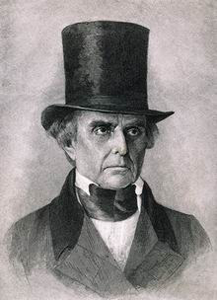
Daniel Webster, American Statesman
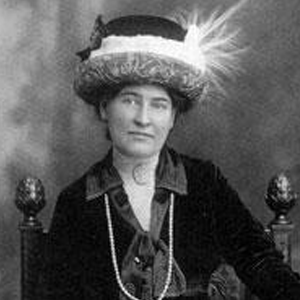
Willa Cather

Burlington Depot, 437 W. Welsch, Red Cloud
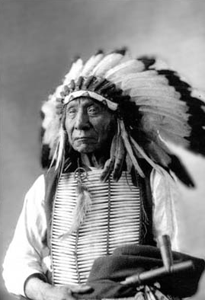
Chief Red Cloud of the Oglala Sioux
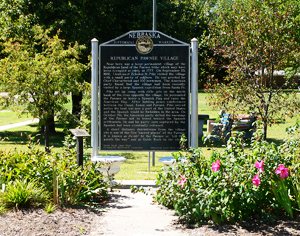
Republican Pawnee Village Marker in Guide Rock. The village site is located just outside of town.
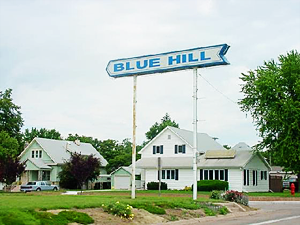
Blue Hill

Webster County Fair & Rodeo. Held the 4th weekend of July in Bladen.
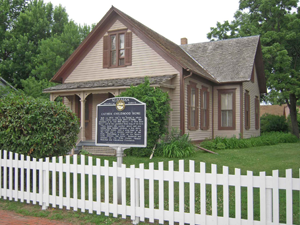
Willa Cather’s Childhood Home, 241 N. Cedar, Red Cloud
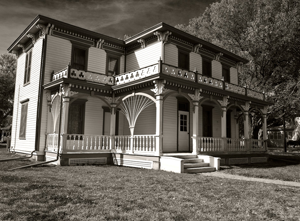
The Harling House, 241 N. Seward, Red Cloud
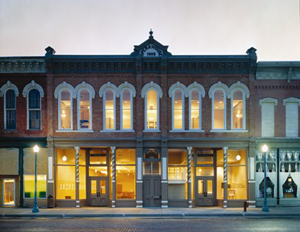
Red Cloud Opera House, 413 N. Webster
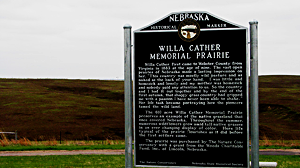
Willa Cather Memorial Prairie, 5 miles south of Red Cloud
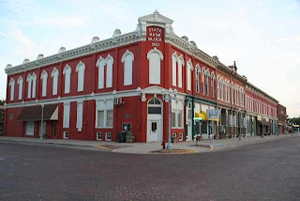
Downtown Red Cloud, Hwy 136 & Hwy 281

1884 Baptist Church in Red Cloud (near 5th & Seward)

St. Juliana Falconieri Catholic Church, 425 W. 3rd St. in Red Cloud
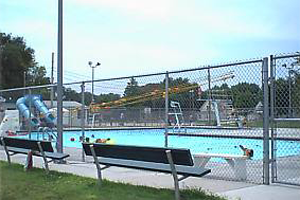
Red Cloud Municipal Swimming Pool (near 3rd & Webster)

